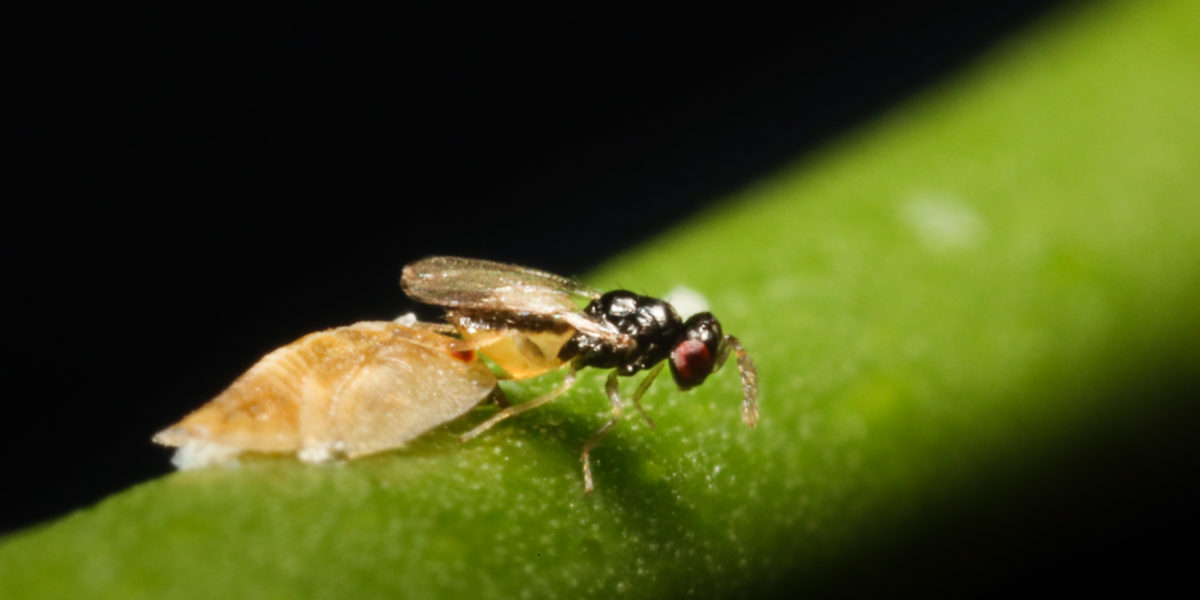
Our Citrus Crops Are Under Attack. Meet the Cute Wasp That Could Save Them
A tiny insect is threatening California’s $4Bn. citrus industry. Is a battle royale with another tiny insect our only hope?

Mike Lewis
A tiny insect war is being waged in our backyards—one that’s threatening California’s $4 billion citrus industry. Now it’s popped up in San Bernardino County: a bacterial disease known as Huanglongbing, or citrus greening disease, spread by an insect called the Asian citrus psyllid, has now reached a tree near Montclair.
HLB affects all major parts of the tree, yellowing and killing the leaves, decaying the roots, stunting fruit growth, and greening fruit bottoms. Fruit falls easily off the tree, and the juice is bitter and unusable. The disease can kill a citrus tree in as little as five years, and there is no known cure. Worst of all, it spreads rapidly depending on how quickly psyllids multiply and travel from tree to tree. Up to 12,000 psyllids can accumulate on a single tree during a 60-day flush period. Imagine 12,000 psyllids flying off in every direction possible from one infected tree in a citrus grove. Since psyllids can mature in just a few weeks and fly away, entire groves can become infected with up to 12,000 psyllids per tree in less than 1 year. All of this can happen before most of the trees show any symptoms.
But there’s a contender in the ring against the potentially catastrophic psyllid: a tiny parasitic (and awfully cute, wouldn’t you agree?) wasp called the Tamarixia radiata.
“The Asian citrus psyllid parasitoid is being widely released across Southern California, and increasingly in areas that have been determined to have high risk of Huanglongbing,” Dr. Mark Hoddle, Director of The Center for Invasive Species Research at the University of California Riverside, said.

The tiny Tamarixia wasp
Mike Lewis, Center for Invasive Species Research, UC Riverside
Imported from Pakistan, this cute wasp—shall we anthropomorphize and call it Tammy?— kills psyllid nymphs in two ways. Choose your own adventure:
Round One: Tammy lays an egg under a psyllid nymph, which when it hatches feeds hungrily on the underside of the nymph. Brutal! Tammy’s little baby grows up to be pretty much Sinbad the Houseguest, taking over the empty shell of its host and pupating inside it. When the baby wasp becomes an adult wasp, it emerges like Athena from the mummified husk’s head, victorious and ready for love. If a female, it will fly out and look for more psyllid nymphs to attack.
Ding ding ding ding!
Round Two: In a move that makes “Basic Instinct” look like it could be on Disney+, Tammy uses her egg-laying tube to stab the psyllid nymph and feeds on the hemolymph (or insect blood) that results. Every Tammy can kill several hundred psyllid nymphs during her lifetime.
But wait, there’s an upset! A surprise WWE-style late entrance is in the ring.
Round Three: There’s a third insect interrupting this mano-a-mano fight between the psyllid and the wasp. The Argentine ant, another invasive species, protects psyllid colonies from the Tamarixia wasp. And there’s a sweet dividend for the gourmand Argentine: honeydew, a sweet waste product that nymphs excrete.

The Asian citrus psyllid
Mike Lewis, Center for Invasive Species Research, UC Riverside
Despite the seemingly brutal antics of the little Tamarixia wasp, it’s become a citrus hero. Huanglongbing has already wreaked havoc on the Florida citrus industry. A worldwide problem, scientists are working to edit genes and breed resistant trees, but in the meantime, the California Department of Food and Agriculture will have to continue breeding and releasing the wasps, as well as destroying and quarantining trees and spraying pesticides. Otherwise, California’s citrus industry could be meet the same fate as Florida’s, which loses ten percent of its citrus trees every year, and according to some experts, could have its citrus industry eliminated within 10 to 15 years.
Tammy’s doing her part—here’s what you can do, including reporting sick trees to the California Department of Food and Agriculture at their toll-free pest hot line at 1-800-491-1899.
